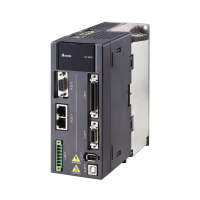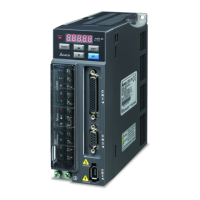Chapter 6 Applied Instructions
6-439
6.21.2 Explanation of String Processing Instructions
API
Instruction code Operand
Function
2100 D
BINDA P
S, D
Converting the singed decimal
number into the ASCII code
Device
X Y M S T C HC D L SM SR E PR K 16#
“$” DF
16-bit instruction (5 steps)
32-bit instruction (5 steps)
AH500 AH500 AH500
Symbol:
S
:
Source value Word/Double word
D
:
Device in which the conversion
result is stored
Word
Explanation:
1. The signed decimal binary number in S is converted into the ASCII code, and the conversion
result is stored in D.
2. The instruction supports SM690, which controls the ending character.
3. The value in S used in the 16-bit instruction should be within the range between -32768 and
32767, and should be a six-digit binary number. The operand D occupies four word devices.
The data is converted as follows.
b15
b0
S
16-bit binary number
b15
b0
b7 b8
D
D
D
D
+1
+2
+3
ASCII code in
the hundreds place
A
SCII code in the
ten thousands place
ASCII code in
the thousands place
Sign (±)
ASCII code in
the units place
ASCII code in
the tens place
Ending character (16#00 or unchanged)
If SM690 is OFF, 16#0000 is stored in D+3. If SM690 is ON, the value in D+3 is unchanged.
Besides, if the value in S is a positive value, the sign character in D is 16#20. If the value in S
is a negative value, the sign character in D is 16#2D. For example, if the value in S is -12345
and SM690 is OFF, the conversion result is as follows.
b15
b0
S
b15
b0
b7 b8
16#31(1)
16#0000
D
D
D
D
+1
+2
+3
16#33(3)
16#35(5)
16#32(2)
16#34(4)
16#2D(-)
-12345
16-bit binary number
4. The value in S used in the 32-bit instruction should be within the range between -2147483648
and 2147483647, and should be an eleven-digit binary number. The operand D occupies six
word devices. The data is converted as follows.

